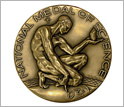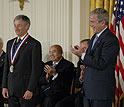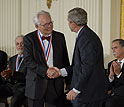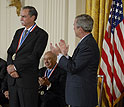News Release 08-166
Eight National Medals of Science Awardees Honored at Gala, Then the White House
Scientific all-stars and experts in engineering, biology, chemistry, physics received awards on September 29

The President and the 2007 National Medals of Science and Technology and Innovation recipients.
September 26, 2008
View a video clip of Leonard Kleinrock showing his contributions to the development of the Internet and cybercommunication.
This material is available primarily for archival purposes. Telephone numbers or other contact information may be out of date; please see current contact information at media contacts.
President George W. Bush awarded the National Medals of Science and National Medals of Technology, honoring the nation's leading researchers, inventors and innovators, at a ceremony in the East Room at the White House at 10 a.m. on Monday, September 29, 2008.
The National Science and Technology Medals Foundation, together with the Director of the U.S. Office of Science and Technology Policy, Secretary of Commerce and Director of the National Science Foundation (NSF) held a gala honoring these national medal laureates on the previous evening, September 28, 2008, in Washington, DC.
The 2007 National Medal of Technology and Innovation Laureates were also honored at the September 28 and 29 events. For more information on that award and the 2007 Laureates, visit http://www.uspto.gov/web/offices/com/speeches/08-19-2008ir.htm.
The webcast of the White House ceremony is available at http://www.whitehouse.gov/news/releases/2008/09/20080929-4.html and click on "Video."
2007 National Medal of Science Laureates:
Fay Ajzenberg-Selove - University of Pennsylvania
For her pioneering contributions in nuclear physics that have advanced research into many applications, including energy generation from fusion, dating of artifacts, and nuclear medicine; her passion for teaching; and her outstanding service to her profession.
Fay Ajzenberg-Selove is professor of physics at the University of Pennsylvania. Her principal scholarly work has been the preparation of evaluated reviews and summaries of what is known about the nuclei with mass numbers 5 to 20. These include isotopes of hydrogen, helium, lithium, beryllium, boron, carbon, nitrogen, oxygen, fluorine, neon and sodium. These elements are among the most interesting both from the point of view of basic nuclear research and for understanding the nucleosynthesis of elements in stars. Applied uses include energy generation through fusion, dating of artifacts, and nuclear medicine. Each year, over 1200 scientific papers are written by scientists all over the world dealing with the spectroscopy of the light nuclei; that is, the ways in which these nuclei absorb and emit energy. Ajzenberg-Selove is the author of "Nuclear Spectroscopy and Energy Levels of Nuclei," and has long been active in encouraging women to enter and remain in physics.
In her engaging memoir, "A Matter of Choices: Memoirs of a Female Physicist," Ajzenberg-Selove wrote candidly about her difficult journey to international recognition in physics. She came to America at the age of 15 after narrowly escaping the Nazi takeover of France. She had planned to become an engineer like her father, but switched to physics after she was told the only engineering jobs open to women were in drafting. Marie Curie's example proved to her that women could do physics. Though she deemed her first attempt at graduate work at Columbia University a disaster, she was struck with the intellectual beauty of the field. When she became a nuclear physicist, the number of women in the field could be counted on one hand. Among her victories, she overcame battles to become a tenured professor and to overcome breast cancer--concurrently.
Ajzenberg-Selove earned a Ph.D. in physics at the University of Wisconsin and did post-doctoral work at the California Institute of Technology (CalTech).
Mostafa El-Sayed - Georgia Institute of Technology
For his seminal contributions to our understanding of the electronic and optical properties of nano-materials and to their applications in nano-catalysis and nano-medicine; his humanitarian efforts in promoting the exchange of ideas; and his role in developing the scientific leadership of tomorrow.
Mostafa El-Sayed, an Egyptian-American chemical physicist and leading nanoscience researcher, is known for the spectroscopy rule named after him, the "El-Sayed Rule." He is currently the Julius Brown Chair and Regents Professor of Chemistry and Biochemistry at the Georgia Institute of Technology, where he heads the Laser Dynamics Lab. His lab is known for the development of the gold nanorod technology. A major focus of his lab currently is the optical and chemical properties of noble metal nanoparticles and their applications in nanocatalysis, nanophotonics and nanomedicine.
El-Sayed and his research group have contributed to many important areas of physical and materials chemistry research. Research interests include the use of steady-state and ultrafast laser spectroscopy to understand relaxation, transport and conversion of energy in molecules, in solids, in photosynthetic systems, semiconductor quantum dots and metal nanostructures. The El-Sayed group has also been involved in the development of new techniques such as magnetophoto selection, picosecond Raman spectroscopy and phosphorescence microwave double resonance spectroscopy.
El-Sayed earned his doctoral degree from Florida State University and his bachelor of science degree at Ein Shams University in Cairo, Egypt.
Leonard Kleinrock - University of California, Los Angeles
For his fundamental contributions to the mathematical theory of modern data networks, and for the functional specification of packet switching, which is the foundation of Internet technology. His mentoring of generations of students has led to the commercialization of technologies that have transformed the world.
Now a professor at the University of California Los Angeles (UCLA) where he's been for more than the last four decades, Leonard Kleinrock may indeed be called the "Father of the Internet." He created the basic principles of packet switching, the technology underpinning the Internet, while a graduate student at the Massachusetts Institute of Technology (MIT). In this effort, he developed the mathematical theory of data networks. This was a decade before the birth of the Internet which occurred when his host computer at UCLA became the first node of the Internet in 1969. He wrote the first paper and published the first book on the subject; he also directed the transmission of the first message to pass over the Internet. He set up and ran the Internet measurement facility that stressed the early Internet to establish its performance limits and to evaluate its performance and behavior. In these efforts, he laid the groundwork and established the discipline by which future generations of engineers would seek to model, measure and evaluate the computer and communication systems they were building. (See attached NSF Special Report on the Internet and the interview with Leonard Kleinrock).
Kleinrock graduated from the Bronx High School of Science, received a Bachelors in Electrical Engineering from the City College of New York, and a master's and a Ph.D. in Electrical Engineering and Computer Sciences from MIT.
Robert Lefkowitz - Duke University
For his discovery of the seven transmembrane receptors, deemed the largest, most versatile, and most therapeutically accessible receptor signaling system, and for describing the general mechanism of their regulation, influencing all fields of medical practice.
Robert Lefkowitz is an American physician best known for his work with G protein-coupled receptors. He is the James B. Duke Professor of Medicine and Biochemistry at Duke University, as well as an investigator for the Howard Hughes Medical Institute. His research program is concerned with the molecular properties and regulatory mechanisms that control the function of plasma membrane receptors for hormones and drugs under normal and pathological circumstances.
Cells in the human body are constantly exposed to a variety of chemical signals-hormones, neurotranmitters, growth factors, and sometimes even drugs-that they need to interpret and translate into a response. This task is handled by receptors that dot cell membranes. Lefkowitz has essentially defined the field of receptor biology through his work with G protein-coupled receptors, the largest and most pervasive family of cell receptors. A thousand or more of these receptors are known to exist through the body, playing critical roles in sight, smell, and taste, and in regulating heart rate, blood pressure, pain tolerance, glucose metabolism and virtually all known physiological processes.
A two-year fellowship at the National Institutes of health early in Lefkowitz's career sparked his interest in receptor biology, a field that was then in its infancy. At that time, experiments in other laboratories had only suggested the presence of cell receptors, but no one had ever proved their existence. Lefkowitz was convinced they were real, and he set out to isolate them. He also discovered two new families of proteins that desensitize G protein-coupled receptors-a finding that has helped scientists understand, in molecular terms, how receptors become tolerant to certain drugs and may eventually lead to new treatments for human diseases, including heart failure.
From Columbia University, Lefkowitz received his B.A. in Chemistry as well as his M.D.
Bert W. O'Malley - Baylor College of Medicine
For his pioneering work on the molecular mechanisms of steroid hormone action and hormone receptors and coactivators, which has had a profound impact on our knowledge of steroid hormones in normal development and in diseases, including cancer.
Bert O'Malley is currently the Tom Thompson Distinguished Service Professor of Molecular and Cellular Biology at Baylor College of Medicine where he built one of the finest departments in the country over the last thirty years. The department was one of the first of a new generation of departments which combined the merging disciplines of cell structure, molecular biology, and developmental biology into a unified Department of Molecular and Cellular Biology.
His laboratory group is interested in determining the fundamental mechanisms for regulation of eukaryotic gene expression. Their early work defined the "primary molecular endocrine pathway" by which steroid hormones act in target cells. They showed that steroid hormones regulate de novo synthesis of specific proteins by regulating the levels of specific mRNAs in target cells. Using cell-free transcription methods, they substantiated "initiation of transcription" as the rate-limited step at which nuclear receptors regulate gene expression and defined steroid hormone receptors as transcription factors.
Prior to serving at Baylor College, O'Malley spent four years at the Vanderbilt University as the Luscious Birch Professor and Director of the Reproductive Biology Center, and another four years at the National Institutes of Health as Molecular Biology section head at the Eunice Kennedy Shriver National Institute of Child Health and Human Development.
O'Malley graduated from the University of Pittsburgh School of Medicine and did his clinical residency at Duke University Medical Center.
Charles P. Slichter - University of Illinois at Urbana-Champaign
For establishing nuclear magnetic resonance as a powerful tool to reveal the fundamental molecular properties of liquids and solids. His inspired teaching has led generations of physicists and chemists to develop a host of modern technologies in condensed matter physics, chemistry, biology, and medicine.
Professor Charles Slichter, internationally recognized in condensed matter physics, is one of the world's top research scientists in the area of magnetic resonance, as well as a leading innovator in applications of resonance techniques to understanding the structure of matter. Slichter's deep physical insight and elegant experimental mastery have allowed him to make seminal contributions to an extraordinarily broad range of problems of great theoretical interest and technological importance in physics and chemistry.
While now retired from teaching, Slichter maintains an active research program and remains a vital presence in the physics department. His textbook, Principles of Magnetic Resonance, now in its third printing, has served as the standard in the field for three and a half decades.
Charles Slichter received his A.B., M.A. and Ph.D. degrees, all in physics, from Harvard University.
Andrew J. Viterbi - University of Southern California
For his development of the maximum-likelihood algorithm for convolutional coding, known as the "Viterbi algorithm," and for his contributions to Code Division Multiple Access (CDMA) wireless technology that transformed the theory and practice of digital communications.
Andrew Viterbi is a pioneer in the field of wireless communications. Viterbi was a member of the communications research section of the Jet Propulsion Laboratory at CalTech where he was one of the first communication engineers to recognize the potential of digital transmission techniques for space and satellite telecommunications systems. Today all four international standards for digital cellular telephony utilize the Viterbi algorithm for interference suppression, as do most digital satellite communications systems.
Viterbi was a co-founder of Linkabit, a small military contractor, and co-founded QualComm with Irwin Jacobs. He created the Viterbi Algorithm for interference suppression and efficient decoding of a digital transmission sequence, used by all four international standards for digital cellular telephony. QualComm is the recognized pioneer of the Code Division Multiple Access (CDMA) digital wireless technology, which allows many users to share the same radio frequencies, and thereby increase system capacity many times over analog system capacity.
Viterbi received his bachelor's and master's degrees from MIT, and his Ph.D. in digital communications from the University of Southern California. He is a USC trustee and the namesake of the USC Viterbi School of Engineering where he holds the USC Presidential Chair.
David Wineland - National Institute of Standards and Technology - Boulder, CO
For his leadership in developing the science of laser cooling and manipulation of ions, with applications in precise measurements and standards, quantum computing, and fundamental tests of quantum mechanics; his major impact on the international scientific community through the training of scientists; and his outstanding publications.
David Wineland joined the U.S. Department of Commerce's National Institutes of Standards and Technology (NIST), when it was the Bureau of National Standards. As leader of the Ion-Storage Group in the Time and Frequency Division at Bolder, CO, his research concentrates on laser cooling and spectroscopy of trapped atomic ions with applications to atomic clocks, quantum-limited metrology, and quantum start control. Wineland's work led to the development of laser-cooled atomic clocks, the current state of the art in time and frequency standards.
Wineland is internationally recognized for developing the techniques of using lasers to cool ions (electrically charged atoms or molecules) to near absolute zero, the coldest possible temperature. He achieved the first demonstration of laser cooling and has built on that breakthrough with thirty years of experiments that represent the first or best in the world-often both-in using trapped laser-cooled ions to test theories in quantum physics and demonstrate crucial applications such as new forms of computation.
Wineland received his bachelor's degree from the University of California Berkeley and master's and doctoral degrees in physics from Harvard University, where his advisor was Norman Ramsey, a 1989 Nobel Laureate in physics. Before joining NIST, Wineland worked as a postdoctoral research associate at the University of Washington with Hans Dehmelt, who shared the 1989 Nobel Physics prize with Ramsey.
-NSF-
-
View Video
National Medal of Science winner Leonard Kleinrock describes the first data transfer on the Internet
Credit and Larger Version -
National Medal of Science
Credit and Larger Version -
2007 National Medal of Science Awardee Faye Ajzenberg-Selove
Credit and Larger Version -
2007 National Medal of Science Awardee Mostafa A. El-Sayed
Credit and Larger Version -
2007 National Medal of Science Awardee Leonard Kleinrock
Credit and Larger Version -
2007 National Medal of Science Awardee Robert Lefkowitz
Credit and Larger Version -
2007 National Medal of Science Awardee Bert O'Malley
Credit and Larger Version -
2007 National Medal of Science Awardee Charles Slichter
Credit and Larger Version -
2007 National Medal of Science Awardee Andrew Viterbi
Credit and Larger Version -
2007 National Medal of Science Awardee Dave Wineland
Credit and Larger Version
Media Contacts
Lisa-Joy Zgorski, NSF, (703) 292-8311, email: lisajoy@nsf.gov
Kirstin Scuderi, USTP, (202) 456-6124, email: kscuderi@ostp.eop.gov
Program Contacts
Mayra N. Montrose, NSF, (703) 292-4757, email: mmontros@nsf.gov
Related Websites
National Science and Technology Medals Foundation: http://www.nationalmedals.org/
Interview with Fay Ajzenberg-Selove, published in Penn Current on Sept. 18, 2008: http://www.upenn.edu/pennnews/current/
Press Release about Mostafa El-Sayed: http://www.gatech.edu/newsroom/release.html?id=2068
UCLA Press Release about Leonard Kleinrock: http://newsroom.ucla.edu/releases/ucla-s-leonard-kleinrock-to-receive-55898
NSF Special Report on the Internet: http://www.nsf.gov/news/special_reports/nsf-net/
Duke Press Release about Robert Leftowitz: http://www.webwire.com/ViewPressRel.asp?aId=73521
Baylor College Feature on Bert O'Malley: http://www.bcm.edu/news/features/
UIUC Press Release about Charles Slichter: http://www.news.uiuc.edu/news/08/0826medal.html
Press release about Andrew Viterbi: http://viterbi.usc.edu/news/news/2008/usc-s-viterbi.htm
NIST Press Release about David Wineland: http://1.usa.gov/1oUtW0O
The U.S. National Science Foundation propels the nation forward by advancing fundamental research in all fields of science and engineering. NSF supports research and people by providing facilities, instruments and funding to support their ingenuity and sustain the U.S. as a global leader in research and innovation. With a fiscal year 2023 budget of $9.5 billion, NSF funds reach all 50 states through grants to nearly 2,000 colleges, universities and institutions. Each year, NSF receives more than 40,000 competitive proposals and makes about 11,000 new awards. Those awards include support for cooperative research with industry, Arctic and Antarctic research and operations, and U.S. participation in international scientific efforts.
Connect with us online
NSF website: nsf.gov
NSF News: nsf.gov/news
For News Media: nsf.gov/news/newsroom
Statistics: nsf.gov/statistics/
Awards database: nsf.gov/awardsearch/
Follow us on social
Twitter: twitter.com/NSF
Facebook: facebook.com/US.NSF
Instagram: instagram.com/nsfgov










